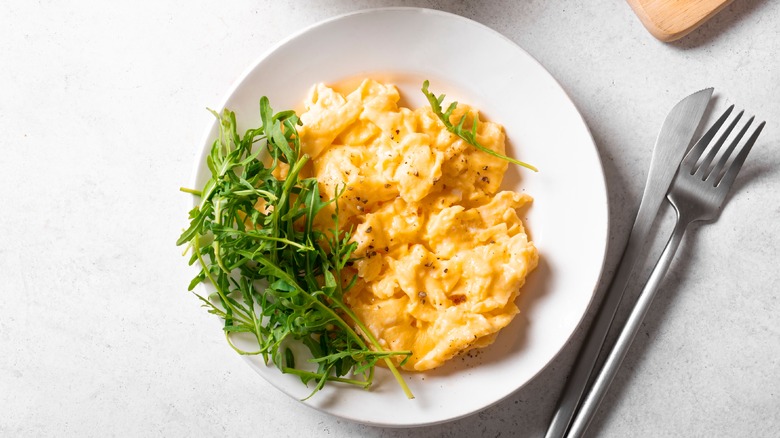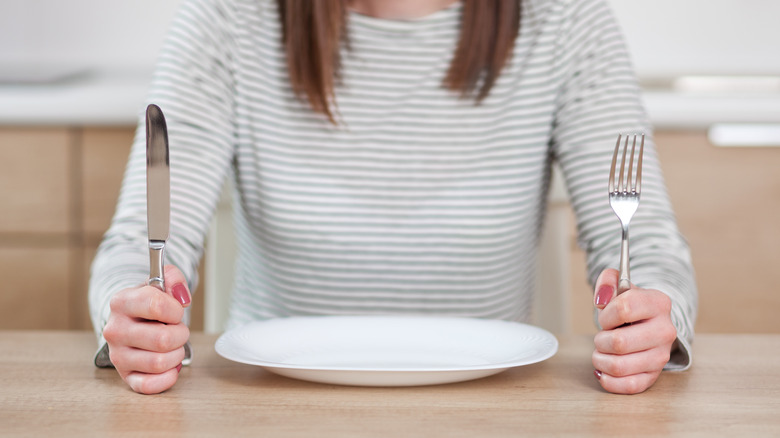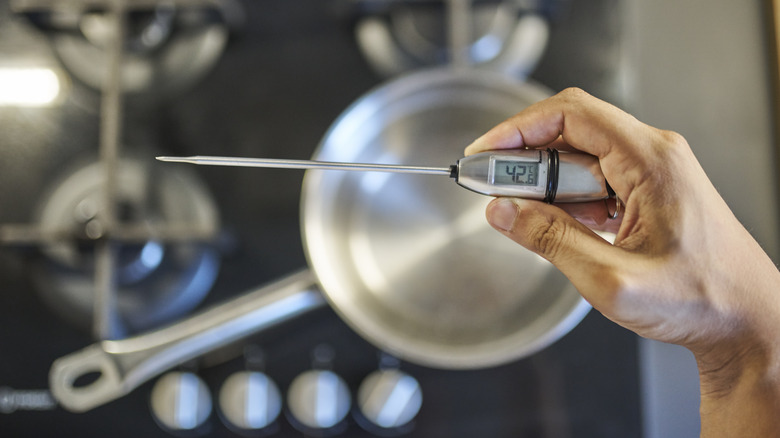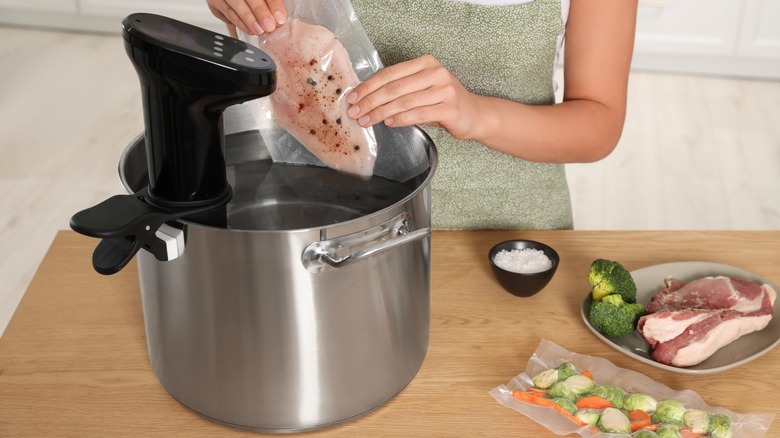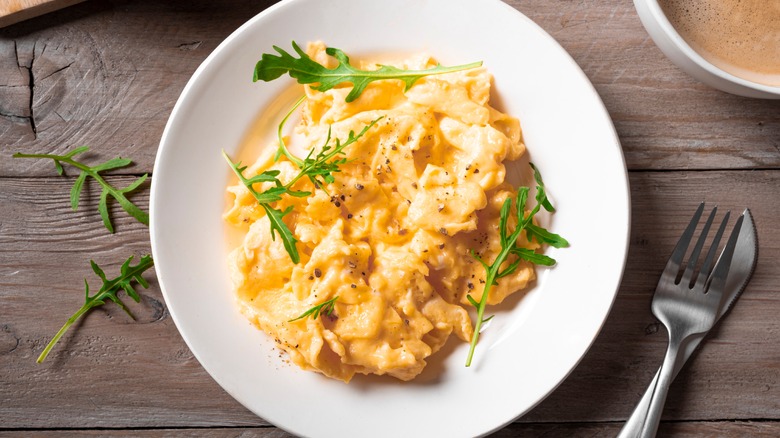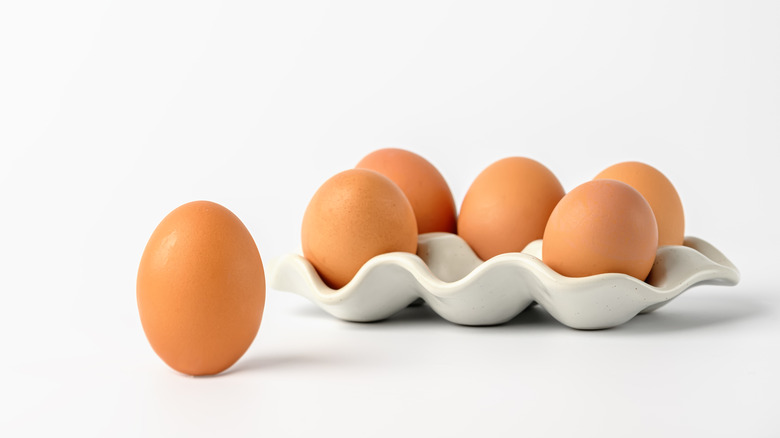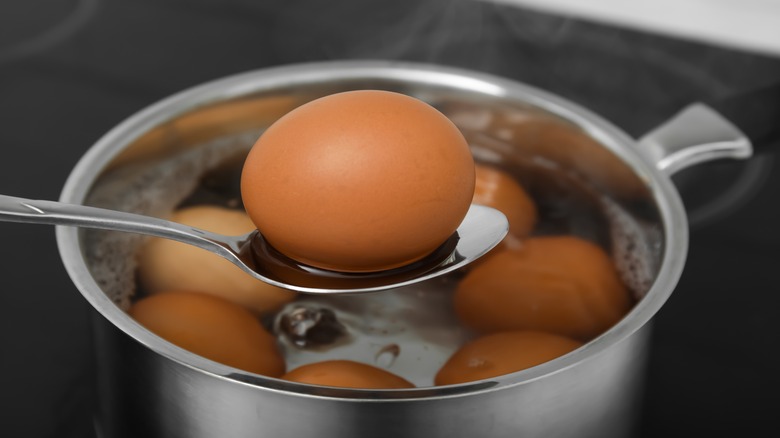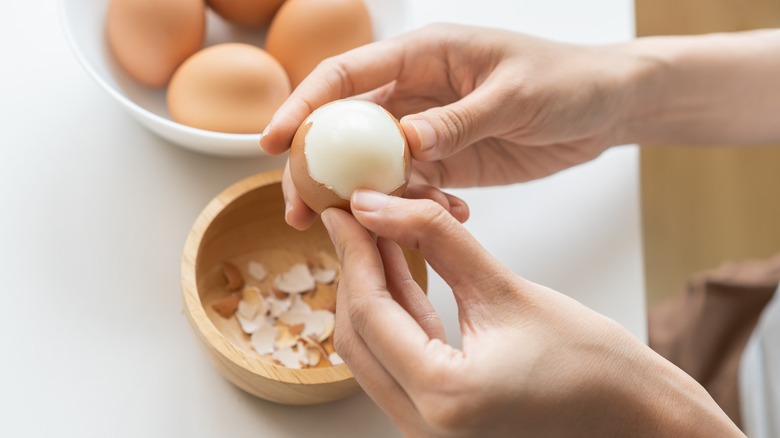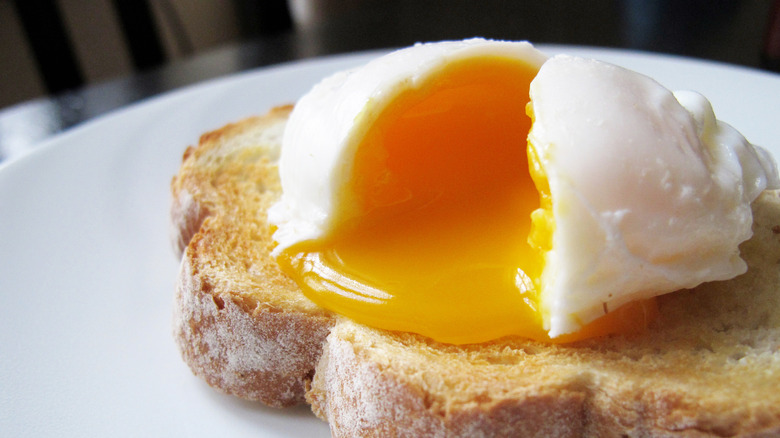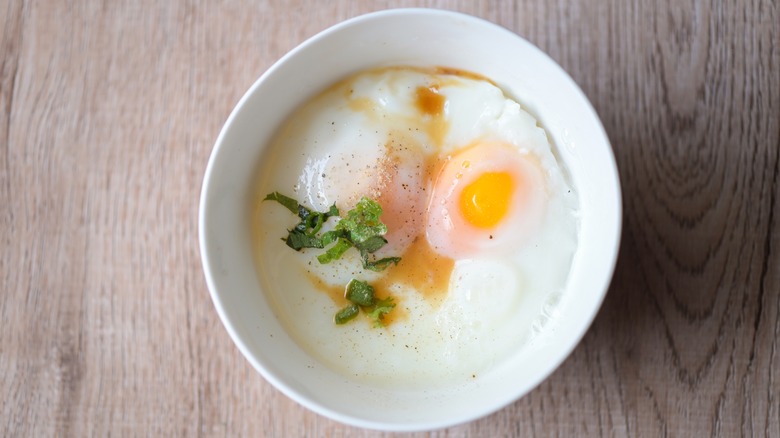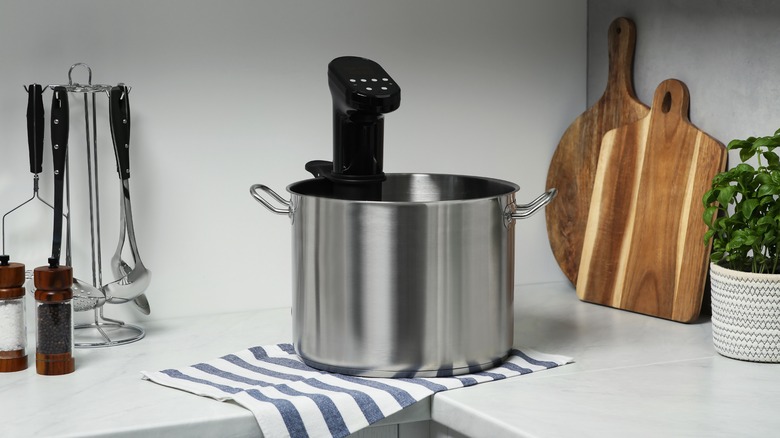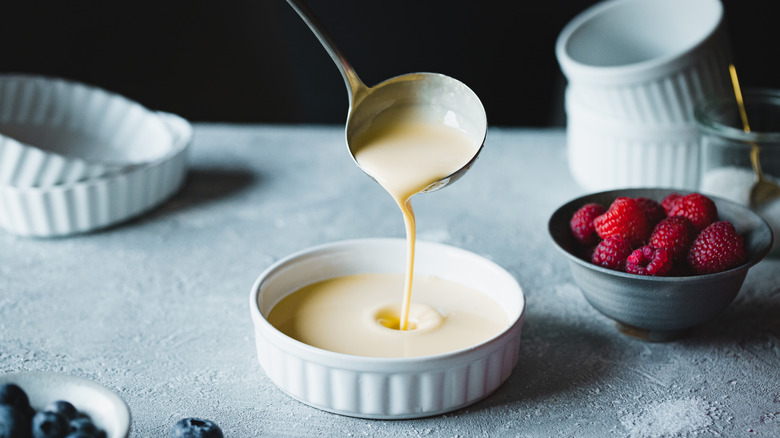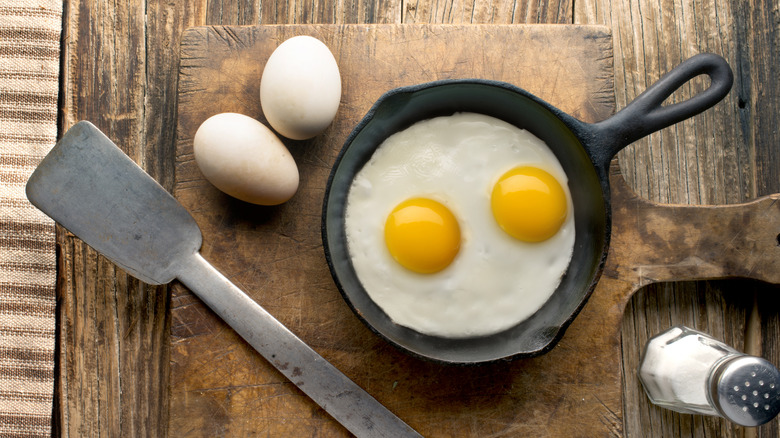Everything You Need To Know About Sous Vide Eggs
When it comes to cooking eggs, there is no shortage of options. There are the obvious choices of scrambling, boiling, and frying, and the unusual ways to cook eggs that you probably haven't tried yet. For example, you can cook them in a muffin tin without removing the shells, scramble them with nothing more than a steamer from an espresso machine, and even throw them in an Instant Pot. But regardless of how you decide to do it, you always want to make sure that the end result is tender and springy rather than tough and rubbery the way eggs so often can be. In this regard, the sous vide method is head and shoulders above the rest. Not only does it rival the traditional methods of egg-making, it puts them to shame.
Chelsea Cole, the cookbook author and recipe developer behind A Duck's Oven, explained why the cooking technique has become so popular in recent years. "When you sous vide, your food goes into a sealed container (typically a glass jar or vacuum-sealed bag), and then into a temperature controlled water bath," she said. "This method is amazing because the cooking environment (the water bath) is the exact temperature you want your food to reach, so it's impossible to overcook." To learn more about this method and how it can be used to make the best eggs you've ever tasted, we spoke with Cole and recipe developer and food blogger Justin McChesney-Wachs of Salt and Pepper Skillet.
It requires patience
The most important thing to factor in when deciding whether or not to make sous vide eggs is that it takes time. Scrambling an egg might only take only a few minutes, but it won't produce the same softer-than-velvet results. As Chelsea Cole explained, "When you cook in something like an oven, the cooking environment is much hotter than the temperature you want your food to reach, so you're just hoping you hit that timing sweet spot and can find yourself frequently over- or undercooking your food. Yes, your food will cook faster that way, but you have to watch it carefully and hope for the best."
So, how much time should you be setting aside? The short answer is that it varies. If you use a relatively high temperature of 165 degrees Fahrenheit, you only have to cook it for about 15 minutes. If you choose a lower temperature, however, you might be waiting a good 45 minutes until the whites turn from translucent to opaque.
Timing and temperature are everything
You'll hear a lot about timing when you look into the sous vide method, whether you're looking to poach an egg or make a steak. But the timing is inextricably linked to the temperature. Turn up the heat and you'll need to reduce the amount of time you let the egg cook. Reduce the heat and you'll need to increase the cooking time.
However, this doesn't mean you'll end up with the same results as long as you adjust these factors in relation to each other. Below 135 degrees Fahrenheit, your egg will show no sign of cooking whatsoever, no matter how many hours you let it sit in the water. If you want to sterilize it for eggnog, this is the perfect method, but don't expect to leave the eggs at this temperature in the morning and come home from work in the evening to solid yolks or even opaque whites.
Above 135 degrees Fahrenheit, your egg will start to show signs of cooking, but it isn't until around 140 degrees Fahrenheit that it will start to look like something you'd want to eat.
It's more difficult than making sous vide meat
As Chelsea Cole acknowledged, sous vide eggs fall into an inconvenient timing window compared to other foods cooked by this method. "When cooking something like a steak or pork chops, you have huge ranges of time, typically 2 to 4 hours, that your food can cook," she said. "We love this because it gives us so much flexibility! When cooking more delicate proteins like seafood and eggs, that window of time is much smaller. You still have slightly more wiggle room, but not much. Be careful to set a timer for your more delicate proteins."
While you can probably get away with leaving steak in its water bath while you rush to pick the kids up from school or make a quick run to the grocery store, time is not on your side with eggs. That 15 to 45 minute zone doesn't allow you to do much of anything except try very hard to not forget when they're done. You won't have to worry about setting the house on fire the way you would if you were cooking them on the stove top, but you do have to worry about overcooking them into tough rubber. Setting an alarm is imperative, and making sure you start long before your tummy starts to grumble is a close second.
The texture is second to none
Based on all these points of caution, you might be wondering why on earth anyone would rather sous vide an egg than boil or poach it. The answer is simple: texture. If you thought you'd mastered the art of the perfect springy hard-boiled egg or the perfect glossy bounce of a poached egg, it's time to try the sous vide method to see just how springy, soft, and velvety you can get this tricky protein.
As Justin McChesney-Wachs told us, "Cooking eggs sous vide gives you precise control over the doneness while cooking at lower temperature than you would in a pan or in boiling water." Boiling water can turn your eggs rubbery before you know it, and if you're poaching eggs and are worried about the whites dispersing before they cook, you might be tempted to turn up the heat even more. In contrast, cooking eggs in their shell at a low temperature will produce the most tender, buttery soft texture you could dream of.
High-quality eggs are a necessity
Finding the proper temperature to time ratio is the trickiest part of making sous vide eggs, but there are still several factors to consider. According to Justin McChesney-Wachs, one of the most common mistakes people make is using low-quality eggs. He stresses that they should be fresh and used straight out of the refrigerator. You'll often see recipes for baked goods that call for bringing the eggs to room temperature first, but this is specific to baking, when you want your ingredients to blend smoothly. Sous vide eggs need to be as fresh as possible, and the refrigerator helps preserve them.
If you're wondering what to look for when buying eggs, make sure you're choosing ones that are listed as grade A or AA, as they are fresher and higher quality. If you're trying to figure out whether the cartons in your fridge are fresh enough to use, there are several signs that eggs are no longer safe to eat, including cracked shells, past expiration dates, and unpleasant odors.
You should start by test cooking
We know what you're thinking. Who has time to test cook an egg, especially when the method you're using is already notoriously time consuming? The truth is, it will almost certainly save you time in the long run. In fact, as Justin McChesney-Wachs told us, not practicing the sous vide method is the single biggest mistake he sees people make. "Since your eggs might be a different size, the timing can be slightly different," he explained. "And since egg doneness is a personal preference, you want to test out different times and temperatures to get it perfect for you. It's not a one-size-fits-all type of cook."
It's also worth noting that the size of the egg has no bearing on its quality, so if you do find that smaller eggs produce less satisfactory results than larger ones — or vice versa — it's worth testing your temperature and timings before ditching them and buying different ones. If you're cooking more than one egg at a time, you'll either need to have two timers going to account for their different sizes, or make sure that you only cook eggs of the same size.
Cracking the eggs takes patience, too
One of the trickiest parts of sous vide eggs is peeling them once they're cooked. If you thought peeling the shells of hard-boiled eggs was challenging, try doing it with a poached egg. Since the whites are more delicate when you use the sous vide method, you'll need to take a few precautions to ensure you don't end up with a gooey puddle of egg white full of broken bits of shell. Luckily, Justin McChesney-Wachs broke the steps down for us.
First of all, you'll want to run the cooked egg under a stream of cold water for 10 seconds to cool it slightly. This won't be as painful on your fingers as it would be with a boiled egg since the temperature of the cooking water is so much cooler. Then, tap the larger end of the egg on the counter and peel the opening enough for the whole egg to slide out into an awaiting bowl. If it doesn't slide out easily, scoop it out of the shell with a small spoon.
McChesney-Wachs also noted that egg toppers can be a useful alternative for this stage. Instead of creating small cracks that you can gently peel back, they snap a clean circular crack around one end of the egg that allows you to lift off a large part of the shell right away.
It's the best way to make poached eggs ahead of time
There is no way around it: poached eggs are a pain to make and one of the most unpredictable two-ingredient recipes out there (or three if you're adding vinegar). To make matters even more annoying, you can't make them ahead of time. Imagine spooning a perfect poached egg out of the water only to have it sit on a plate for 20 minutes. This isn't ideal from a food safety perspective, nor is it ideal from a textural perspective. Let a poached egg sit for too long and it will become dry, rubbery, and cold. If you heat it, it will only get more rubbery.
Poaching eggs via the sous vide method allows you to not only take the guesswork out of it — no shaggy, stiff egg whites or overcooked yolks — but make it ahead of time. It takes a little patience, but if you're making them in advance anyway, that shouldn't be an issue. Start by cooking whole eggs for 45 minutes in a bath of water that is 145 degrees Fahrenheit. Remove them from the water and refrigerate them (still in their shells) until you're ready to use them. You can even do this overnight. A few minutes before you plan to serve them, gently remove them from their shells and let them slide into a small bowl. Transfer them with a slotted spoon into simmering water for about a minute, and marvel at the results.
Sous vide eggs are part of Japanese cuisine
Although the sous vide method has grown in popularity over the past few years, cooking eggs in warm water is nothing new in Japanese cuisine. Called onsen tamago (hot spring eggs), the recipe is traditionally made by slow poaching eggs in their shells in the many volcanic hot springs that are dotted around the country. For tourists staying near one of the thousands of natural hot springs in Japan, it is not uncommon for these silky eggs to be served for breakfast.
Even if you don't have access to one of these natural wonders, you can mimic the temperature of the water with a sous vide immersion circulator. Anywhere from 150 to 160 degrees Fahrenheit will yield the perfect results, though make sure to adjust the timing depending on what part of that spectrum you're using. Twenty to 30 minutes should be plenty of time to achieve the ideal results. You can serve onsen tamago however you enjoy extra silky poached eggs, but in Japan, they are often served over rice or with soy sauce.
You can make sous vide eggs without an immersion circulator
If your kitchen is already overflowing with barely-used gadgets or you simply can't justify the added expense, you'll be glad to know that you don't have to have an immersion circulator to make sous vide eggs. (If you do want to buy one, however, we have a guide to the best sous vide machines that will point you in the right direction). You don't even need your own volcanic hot spring. The trick is to keep the water at a steady temperature for over at least 15 minutes, depending on how long you plan to cook the eggs. You also need to do this without using a direct source of heat, such as a burner, since it will not produce even distribution.
The easiest method is to use the oven. Put the eggs in a heat-proof bowl and submerge them in warm water. Put a thermometer in the water so that you can monitor the temperature throughout the cooking process. With the bowl on the center rack in the oven, bring the water to the desired temperature and let the eggs cook for your preferred duration. Make sure that the oven is not too hot. It will probably feel strange to turn the oven on and barely feel heat coming from it when you open the door, but remember that the water must be kept at a low temperature to achieve the desired results.
You can make sous vide eggs in a bag or jars
Many sous vide egg recipes focus on cooking the eggs in their shells, but that limits the variety of options you can make. Sure, you can achieve some pretty heavenly poached eggs this way and indulge in the best hard-boiled eggs of your life, but leaving them in their shells prevents you from mimicking other types of beloved eggs. Chief among them is scrambled eggs, the go-to breakfast item of many home cooks the world over. All you need to make impossibly pillowy, tender scrambled eggs with your sous vide machine is a proper sous vide bag.
Start by cracking the eggs and whipping them with milk, water, or any of the other liquid ingredients that make scrambled eggs delicious. Then, seal them in a bag and submerge them in a water bath that is set at around 167 degrees Fahrenheit. Let the eggs cook for about 15 minutes, or until they are becoming solid but not rubbery. As they cook, remove the bag from the water periodically and massage the eggs to ensure that they cook evenly.
Another option is to make egg bites like the ones you might cook in muffin tins in the oven. Instead of pouring the egg mixture in a bag, use heat-proof jars and let the eggs cook for about an hour until they are firm enough to hold their shape.
It's a great way to make custard
One of the most underrated uses for sous vide eggs is custard. If you've ever tried to make custard on the stove only to end up with scrambled eggs, you're not alone. It is one of the most frustrating and potentially inevitable struggles of custard-making, and one that, once you bring the sous vide method into it, is entirely preventable. Whether you're making crème brûlée or, as Chelsea Cole recommended, ice cream, the sous vide method will quickly become your secret weapon.
The struggle with custard is that you need the eggs to cook but not scramble. If they scramble, you'll have sweet liquid full of lumpy bits of eggs. By keeping the mixture at a constant temperature just below the point where they will begin to scramble, you will achieve the perfect custard. To do this, the water must stay between 167 and 176 degrees Fahrenheit. Anything below this and they won't begin to set, anything above it and they will become solid and lumpy. Cole recommends cooking them at 175 degrees Fahrenheit for one hour.
There are some instances when you shouldn't sous vide eggs
There are a lot of things you can do with the sous vide method, especially when it comes to making eggs. In many of these cases, slow cooking actually makes the eggs tastier than they would otherwise be, thanks to the velvety smooth texture you can achieve. However, there are some situations when it isn't the ideal option. The most obvious is fried eggs. There is simply no way to achieve crispy edges with the sous vide method because you need excessive heat, preferably dry.
The other situation when sous vide eggs aren't the best option is when you're in a hurry. Our best scrambled egg recipe takes only six minutes to make from start to finish, which is less than half the time it takes to make sous vide eggs at maximum speed. If you're rushing to get breakfast on the table, you're much better off sticking to more traditional egg-making methods than being late to work.
